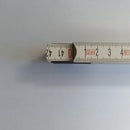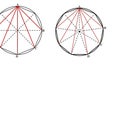Introduction: An Alternative Approach for Finding the Number of Diagonals That Can Be Drawn in a Regular Polygon
The general expression for the number of diagonals that can be drawn in a regular m-sided polygon is:
m (m – 3)/2.
The usual explanation for this expression is based on two facts:
- from each of the m vertices of the polygon one can draw (m – 3) diagonals resulting in a total of m (m – 3) diagonals;
- the diagonal joining the iᵗʰ vertex to the jᵗʰ vertex is identical to the diagonal joining the jᵗʰ vertex to the iᵗʰ vertex so that the total m (m – 3) diagonals is counted twice and thus this total number has to be divided by 2 to give a corrected total of m (m – 3)/2.
Another explanation for this expression using combinations is also based on two facts:
- the number of combinations of pairs of vertices chosen from a set of m vertices is ᵐC₂ (these pairs of vertices are either diagonals or edges);
- since there are m edges, subtracting m from ᵐC₂ gives the number of diagonals as:
ᵐC₂ - m = m! / [(m -2)! 2!] - m = [m (m – 1)/2 -m] = m (m – 3)/2.
In this Instructables we present a different approach for calculating the number of diagonals present in a regular polygon. Although it involves more steps than the approaches presented above, it provides more insight into the nature of the diagonals. In particular, the approach presented here points out the obvious difference between maximum length diagonals (diagonals that have a length greater than that of all the remaining diagonals) when considering polygons with an even number of sides versus those with an odd number of sides.
.
Step 1: Comparison of the Approach Presented Here With That Usually Used for Calculating the Number of Diagonals That Can Be Drawn in a Regular Polygon
The usual approach considers the number of diagonals that can be drawn from each vertex to all the other vertices of the polygon as shown for vertex 1 of the nonagon on the left side of the above diagram.
The present approach considers each of the different types of diagonals that have a certain length and counts the number of diagonals that possess each particular length. The right hand side of the above diagram shows all of the shortest diagonals that can be drawn for a nonagon. Each of these diagonals joins two vertices that have one vertex between what we can consider their starting and end points.
Step 2: Notation
In order to make any headway with describing the different types of diagonals in a polygon, we require a more formal terminology to describe them, rather than using terms like the shortest diagonal, the second shortest diagonal, etc.
We label the different types of diagonals based on the number of vertices of the polygon between the vertices at the ends of the diagonal. Thus a diagonal that has:
- one vertex between the vertices defining its two ends is notated as a D₁ type of diagonal;
- two vertices between the vertices defining its two ends is notated as a D₂ type of diagonal;
- three vertices between the vertices defining its two ends is notated as a D₃ type of diagonal;
etc.
However, this notation is not a unique description of a diagonal as it depends on whether to start counting vertices in a clockwise or anticlockwise direction from the vertex at one end of the diagonal to the vertex at the other end of the diagonal. For example, in the octagon and nonagon in the above diagram, the diagonal line could be classified as a D₂ type if one counts the number of vertices between the vertices labelled 1 and 4 in a clockwise direction, starting at the vertex labelled 1, but can also be classified as a D₄ type for the octagon and a D₅ type for the nonagon, if one counts the number of vertices starting at vertex 1 in an anticlockwise direction.
So one must remember to group the D₂ and D₄ diagonals as one type of diagonal (D₂/D₄) for the octagon and the D₂ and D₅ diagonals as a single type of diagonal (D₂/D₅) for the nonagon.This avoids having to overcount the number of diagonals that posses a certain length.
Step 3: Types of Polygons and Number of Diagonals That Possess a Maximum Length
We consider two classes of polygons:
- those with 2n sides having an even number of sides and vertices (as shown for the octagon in the diagram in the previous step);
- those with (2n + 1) sides having an odd number of sides and vertices (as shown for the nonagon in the diagram in the previous step).
The reason for this distinction becomes obvious when we consider the diagonals with the longest length.
When a polygon has an even number of sides (2n sides) there are n diagonals whose length is greater than all the other diagonals. These diagonals have end vertices that are directly opposite one another with (n - 1) vertices between their end vertices. (They are also diagonals of the circumscribed circle that passes through all the vertices of the polygon.) They are defined as D₍ₙ₋₁₎ type diagonals whether one counts the number of vertices in a clockwise or in an anticlockwise direction from one end of the diagonal to its other end.
When a polygon has an odd number of sides [(2n + 1) sides], choosing one vertex from which to draw a diagonal that has a maximum length results in two possibilities. There are two distant vertices opposite the chosen vertex that have a maximum length from the chosen vertex. (They are not diagonals of the circumscribed circle that passes through all the vertices of the polygon, but rather they are the chords of the circle.) Since there are two such diagonals from each vertex there are thus (4n +2) diagonals having a maximum length. Between the ends of each of these two diagonals there are either (n – 1) vertices or (n + 1) vertices depending on the direction (clockwise or anticlockwise) chosen to count the number of vertices between the vertices describing the origin and end of the diagonal.
When counting the number of diagonals that possess a maximum length for a polygon that has an odd number of sides, these diagonals are classified under the one heading as D₍ₙ₋₁₎/D₍ₙ₊₁₎ type of diagonals.
Step 4: Total Number of Diagonals Each Having a Different Length for an Octagon and a Nonagon
The above Table lists all the pairs of vertices that can give rise to diagonals of different lengths for the octagon (Columns 1 to 3) and the nonagon (Columns 4 to 6).
For the octagon, the third column in the Table lists the pairs of vertices that give rise to those diagonals having a maximum length as described in the previous step. For the nonagon, the last column in the Table lists the pairs of vertices that give rise to those diagonals having a maximum length.
Except for the number of diagonals possessing a maximum length, both the octagon and the nonagon contain the same number of types of diagonals. The octagon has eight D₁ and D₂ types of diagonals, whereas, the nonagon has nine of these same types of diagonals. As regards the diagonals having a maximum length, the octagon has half the number of diagonals possessing a maximum length compared to its D₁ and D₂ types of diagonals, whereas the nonagon has the same number of diagonals having a maximum length as its D₁ and D₂ types of diagonals.
If one tallies the total numbers of diagonals for the octagon and nonagon, the results obtained agree with that found using the expression given in the first sentence of the Introduction to this Instructables (20 diagonals for the octagon and 27 for the nonagon).
Step 5: Total Number of Diagonals for Polygons With Even and Odd Sides
The observations noted in the Table in the previous step hold for all polygons when one compares a polygon with an even number of sides with a polygon that has one additional side. This allows us to write expressions that hold in general for any polygon that has an even number of sides and for any polygon that has an odd number of sides.
For polygons with an even number of sides: there are (n-1) different types of diagonals D₁, D₂,...D₍ₙ₋₂₎ each possessing 2n pairs of vertices except for the diagonals that have a maximum length (D₍ₙ₋₁₎). For these latter type of diagonals, there are n such pairs. The total number of diagonals is thus 2n (n - 2) + n = n( 2n - 3). If we let m = 2n, the total number of diagonals is m (m - 3)/2
For polygons with an odd number of sides: there are (n-1) different types of diagonals D₁, D₂,...D₍ₙ₋₁₎ each possessing (2n + 1) pairs of vertices The total number of diagonals is thus (2n + 1) (n - 1). If we let m = (2n + 1) so that n = (m - 1)/ 2, the total number of diagonals is m (m - 3)/2.











